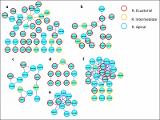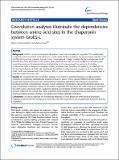Por favor, use este identificador para citar o enlazar a este item:
http://hdl.handle.net/10261/80369COMPARTIR / EXPORTAR:
 SHARE
BASE SHARE
BASE
|
|
| Visualizar otros formatos: MARC | Dublin Core | RDF | ORE | MODS | METS | DIDL | DATACITE | |

| Título: | Coevolution analyses illuminate the dependencies between amino acid sites in the chaperonin system GroES-L |
Autor: | Ruiz-González, Mario X. CSIC ORCID; Fares, Mario A. CSIC ORCID | Fecha de publicación: | 22-jul-2013 | Editor: | BioMed Central | Citación: | BMC Evolutionary Biology. 13(1):156 (2013) | Resumen: | Abstract Background GroESL is a heat-shock protein ubiquitous in bacteria and eukaryotic organelles. This evolutionarily conserved protein is involved in the folding of a wide variety of other proteins in the cytosol, being essential to the cell. The folding activity proceeds through strong conformational changes mediated by the co-chaperonin GroES and ATP. Functions alternative to folding have been previously described for GroEL in different bacterial groups, supporting enormous functional and structural plasticity for this molecule and the existence of a hidden combinatorial code in the protein sequence enabling such functions. Describing this plasticity can shed light on the functional diversity of GroEL. We hypothesize that different overlapping sets of amino acids coevolve within GroEL, GroES and between both these proteins. Shifts in these coevolutionary relationships may inevitably lead to evolution of alternative functions. Results We conducted the first coevolution analyses in an extensive bacterial phylogeny, revealing complex networks of evolutionary dependencies between residues in GroESL. These networks differed among bacterial groups and involved amino acid sites with functional importance and others with previously unsuspected functional potential. Coevolutionary networks formed statistically independent units among bacterial groups and map to structurally continuous regions in the protein, suggesting their functional link. Sites involved in coevolution fell within narrow structural regions, supporting dynamic combinatorial functional links involving similar protein domains. Moreover, coevolving sites within a bacterial group mapped to regions previously identified as involved in folding-unrelated functions, and thus, coevolution may mediate alternative functions. Conclusions Our results highlight the evolutionary plasticity of GroEL across the entire bacterial phylogeny. Evidence on the functional importance of coevolving sites illuminates the as yet unappreciated functional diversity of proteins. | URI: | http://hdl.handle.net/10261/80369 | Identificadores: | http://dx.doi.org/10.1186/1471-2148-13-156 |
| Aparece en las colecciones: | (IBMCP) Artículos |
Ficheros en este ítem:
| Fichero | Descripción | Tamaño | Formato | |
|---|---|---|---|---|
| 1471-2148-13-156.xml | 111,21 kB | XML | Visualizar/Abrir | |
| 1471-2148-13-156-S5.PDF | 162,72 kB | Adobe PDF |  Visualizar/Abrir | |
| 1471-2148-13-156-S4.PDF | 289,51 kB | Adobe PDF |  Visualizar/Abrir | |
| 1471-2148-13-156-S2.PDF | 92,91 kB | Adobe PDF |  Visualizar/Abrir | |
| 1471-2148-13-156-S1.PDF | 298,34 kB | Adobe PDF |  Visualizar/Abrir | |
| 1471-2148-13-156-S3.PDF | 39,63 kB | Adobe PDF |  Visualizar/Abrir | |
| 1471-2148-13-156.pdf | 2,4 MB | Adobe PDF |  Visualizar/Abrir |
CORE Recommender
Page view(s)
305
checked on 16-abr-2024
Download(s)
626
checked on 16-abr-2024
Google ScholarTM
Check
NOTA: Los ítems de Digital.CSIC están protegidos por copyright, con todos los derechos reservados, a menos que se indique lo contrario.
